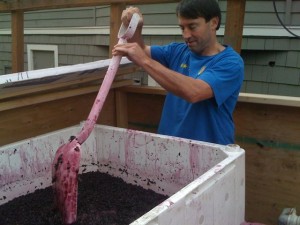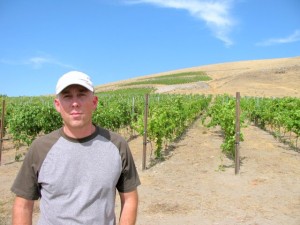I had the pleasure of visiting Cain Vineyards in the Napa Valley and spending an afternoon talking with winemaker/ philosopher Chris Howell and later tasting his wines during a fabulous dinner at Terra Restaurant. Check out his wonderful, subtle, food-friendly wines.
Tag: Wine Making
The Art of Wine Writing and Blending Wine
I enjoy writing about wine in part because I get to participate in the wine making process. I always find elements of beauty, discovery and ancient ritual in wine making. My story about Napa Valley wine touring appears in the March issue of Alaska Airlines Magazine, and includes a section on visiting Conn Creek Winery’s blending facility, which allows visitors to participate in the art of making wine. For those who haven’t already seen it I’ll include below:
WINEMAKER FOR A DAY
The last morning of my Napa visit, I stop in at Conn Creek Winery. After the advice I’ve heard from wine makers, I’m eager to craft my own blend, especially with cabernet, Napa Valley’s most highly regarded varietal. The winery’s AVA Room Barrel Blending Experience provides a rare opportunity to taste and blend wines from the many regions of Napa. Conn Creek’s winemaker Mike McGrath does the hard work of fermenting cabernet from all the regions of Napa including Oakville, Rutherford, Spring Mountain, St. Helena, Stag’s Leap, Yountville and Carneros. Now I get to try my hand at blending them into a perfect bottle, a critical step in the wine-making process . I’ll play winemaker for a day and take home my own blend of cabernet.
“Today, we get to play with wine,” says Karen Trippe, the cheerful hostess at Conn Creek. “We’ll learn the blender’s craft.”
Trippe discusses the uniqueness of the Napa Valley: elevation, temperature variations, variety of soils, which together yield extremely balanced fruit. The blending room houses dozens of 60-gallon French oak barrels, each with a 2008 cabernet wine from a different district of the valley.
It’s simply too much to resist. I systematically sample every wine, from the softer, red berry fruited wines of Oakville, to the bold, ripe, tannic wines of Calistoga. The problem is I like all of them. Where to start?
“Some people want to use all of them,” advises Trippe. “But it’s like using all the crayons to draw a picture; it turns out brown.”
She advises choosing one and building from there. I love the Rutherford wine’s spicy nose, and deep, rich complex fruit, but the wine is very tannic. Trippe advises adding the Oakville sample to round out the blend.
I take out the 100 milliliter graduated cylinder and pour in half Rutherford and half Oakville. I smell and taste it. Rather than enhancing the Rutherford, the Oakville has obscured it.
I change the proportion to 80 percent Rutherford, 15 percent Oakville. Now, the Oakville sample enhances the blend. I taste and sniff. Almost there. I add a dash cabernet franc for aromatics. The blend comes alive as if someone has passed a wand over it.
“A good blend is greater than the sum of its parts,” she says. “That’s the magical part of wine making.”
I sniff the blend, savoring its intoxicating perfume. As much as I enjoy the castles, cathedrals and traditions of Europe, I’ve come under the spell of Napa. I love its friendliness and informality and the conviction that there are new wines to make and new ways to make them. After bottling my blend, I store it carefully in my luggage. I’m already thinking about when to open it and what to serve with it so I might recapture the magic of Napa I’ve enjoyed on this trip.
Home Winemaking Chez O’Connell

Taking a break from writing and teaching, I spent the past fall fermenting our cabernet, merlot and syrah. It’s physical work, but very rewarding, allowing me to get in touch with my inner winemaker. We buy most of our grapes from Ciel du Cheval vineyard on Red Mountain in Eastern Washington. These are some of the best grapes in the state; two wines rated 100 by Robert Parker came out of the same vineyard. As long as I do my job, the eventual wine will be superb. My winemaking partner Tom Remmers and I share winemaking duties and our crew of Les Copains volunteers does a fantastic job of helping us our with crushing, pressing, fermenting and finally bottling. It provides a good break from more cerebral activities like writing and teaching, and allows me to experience winemaking from the ground up.
Grand Rêve Vineyard: The Most Exciting New Vineyard in Washington?

The most exciting new vineyard in Washington could easily be mistaken for a rock quarry. Perched on the side of Red Mountain–perhaps the premier site for red wine grapes in the state–Grand Rêve (big dream in French) slants down a steep, rocky, wind-blasted slope, looking more like a rock garden than a vineyard. Littered with shattered volcanic boulders, cactus and tumbleweeds, the vineyard has proven very difficult to establish, but likely will yield some of the some of the richest syrah, mourvedre and Grenache in the state.
Despite the unusual appearance, Grand Rêve resembles the best terroir in the world. It looks like a combination of Chateauneuf du Pape and the northern Rhone, the rocky cobbles of Chateauneuf tilted on their side, recalling the extraordinary vineyards of Hermitage and Côte Rôtie, home of Guigal, Chapoutier, some of the biggest names in French wine-making.
Co-owner Ryan Johnson gave me a tour of Grand Rêve in September when I came over to pick up merlot grapes from Ciel du Cheval for our Les Copains Winery. As much as I enjoy writing about travel, food and wine, there’s nothing like participating in the process to bring home the romance and frenetic intensity of the crush. It’s this kind of first-hand research that yields the freshest, most detailed stories, a point I make in my writing classes, and one which came back to me again as we climbed over the basaltic rocks and cobbles of the vineyard.
“It’s hard to farm but very promising,” said Johnson, who is also the vineyard manager of Ciel du Cheval Vineyard, one of the premier sites on Red Mountain. He co-owns Grand Rêve with Paul McBride and knows the soils of Red Mountain like few others, having grown grapes there for 10 vintages while also managing Cadence Cara Mia, Galitzine Estate, and DeLille Grand Ciel vineyards, a who’s who of Washington winemaking. He is most excited about his improbable new vineyard.
“We can raise the bar for Red Mountain and Washington State,” he said confidently, citing the unique character of Grand Rêve. The 13-acre vineyard contains 34 parcels, with nine different soil types. Before he started planting, Johnson dug 57 soil pits, trying to figure out exactly what to plant, seeking to match varietals and clones to the individual lots. What he found astonished him: layers of volcanic ash in one parcel, silt over limestone in another, volcanic rocks mixed with silt in yet another—a dizzying variety of terroirs, likely to produce an incredible variety of grapes—if he could only cultivate it.
“It was a lot of work,” said Johnson, of one parcel nick-named El Terror. “The plants were put in with a pick axe and crowbar.”
Walking through the vineyard is more like a rock scramble than a walk, but it’s exactly the kind of ground I visited in May at famed Vieux Telegraphe in Chateauneuf du Pape, where I will return next spring to teach my annual Travel, Food and Wine Writing Class. Such rocky soils yield the tastiest syrah, mourvedre, and Grenache.
Grand Rêve will produce its first fruit next year, with wine to follow shortly, but you can get a hint of what’s in store with the Grand Rêve “Collaboration Series” wines available in limited quantities via mailing list, and through a select number of Puget Sound retailers and restaurants. The Grand Rêve tasting room is located at 12514 130th Lane NE in Kirkland, Washington. (susan@grandrevevintners.com, 425-549-0123).
This collaboration series contains fruit for some of the best sites on Red Mountain, and will whet the appetite for the wild, vertical world of Grand Rêve. Several years ago, Johnson tasted a McCrea Cellars pure Grenache and was blown away by it, inspiring him to make a similar 100-percent varietal from the highest, rockiest parcel on the site.
“It’s a quest,” he admitted as we got back to his pick up. “It’s my Holy Grail.”
The Big Dream is becoming a reality.
 The Writer's Workshop
The Writer's Workshop 











